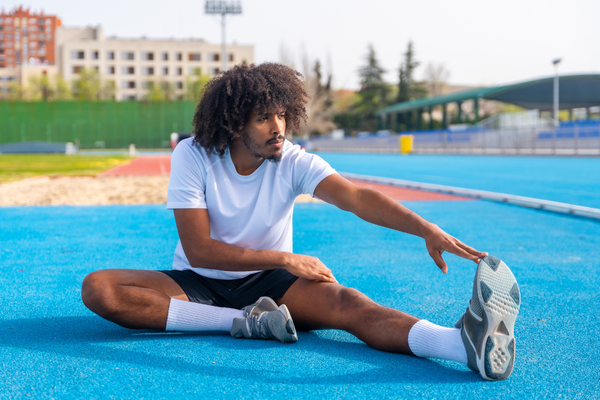Don't let sports injuries sideline you! Learn expert strategies to prevent common injuries and maintain peak performance in every game.
How to Prevent Common Sports Injuries
Sports injuries can sideline even the most dedicated athletes, but they don’t have to be inevitable. By implementing the right precautions and strategies, you can significantly reduce your risk of injury and stay in the game. In this post, we’ll explore the top tips to prevent common sports injuries, so you can maintain your athletic performance and avoid setbacks.
Table of Contents:
- Warm Up and Cool Down Properly
- Focus on Strength and Conditioning
- Use Proper Technique
- Listen to Your Body
- Wear the Right Gear
- Stay Hydrated and Maintain a Healthy Diet
1. Warm Up and Cool Down Properly
One of the simplest yet most effective ways to prevent injuries is by incorporating proper warm-up and cool-down routines into your training. According to the American College of Sports Medicine (ACSM), a good warm-up increases blood flow to the muscles, enhances flexibility, and prepares your body for more intense activity.
Warm-Up:
Start with light aerobic exercises like jogging or cycling, followed by dynamic stretches targeting the muscles you'll use in your sport (American College of Sports Medicine, n.d.).
Cool-Down:
After your workout, cooling down helps your body transition back to a resting state. Slow down your activity gradually, and follow it up with static stretching to maintain flexibility and reduce muscle stiffness (Joyce & Lewindon, 2015).
2. Focus on Strength and Conditioning
Building a strong, resilient body is crucial for preventing sports injuries. Strength training and conditioning not only improve performance but also fortify muscles, tendons, and ligaments against the stresses of athletic activity.
Strength Training:
Incorporate exercises that target the major muscle groups, with a particular focus on the muscles you use most in your sport. Stronger muscles can better support joints and absorb impact, reducing the likelihood of injury (Joyce & Lewindon, 2015).
Conditioning:
Cardiovascular and muscular endurance conditioning helps your body handle the demands of your sport. Consistent conditioning can prevent fatigue, which is often a precursor to injury (Joyce & Lewindon, 2015).
3. Use Proper Technique
Improper technique is a common cause of sports injuries. Whether you're lifting weights, running, or playing a sport, using the correct form is essential to staying injury-free. The Mayo Clinic suggests that improper technique during physical activity increases the risk of injuries, including sprains and strains (Mayo Clinic, n.d.).
Get Professional Guidance:
If you're unsure about your technique, consider working with a coach or trainer who can provide feedback and correct any mistakes (Mayo Clinic, n.d.).
Practice Regularly:
Consistent practice helps reinforce proper technique, making it second nature and reducing the risk of injury during competition or high-intensity workouts (Joyce & Lewindon, 2015).
4. Listen to Your Body
Your body has a way of telling you when something is wrong. Paying attention to those signals can prevent minor issues from becoming major injuries. According to a study in the Journal of Athletic Training, overtraining is a significant risk factor for chronic injuries, such as tendonitis and stress fractures (Bahr, 2014).
Rest When Needed:
If you feel pain or discomfort, especially in your joints or muscles, it’s important to rest and allow your body to recover (Bahr, 2014).
Avoid Overtraining:
Overtraining can lead to chronic injuries like tendonitis or stress fractures. Make sure to balance intense training with adequate rest and recovery time (Bahr, 2014).
5. Wear the Right Gear
Wearing the appropriate gear for your sport is another key aspect of injury prevention. This includes everything from footwear to protective equipment. Proper gear can prevent many common injuries, as highlighted by the National Institutes of Health (NIH, 2017).
Footwear:
Wearing shoes that provide the right support for your activity is essential. Running shoes, for example, should offer good arch support and cushioning, while cleats need to fit properly and provide traction on the field (NIH, 2017).
Protective Gear:
Helmets, pads, braces, and other protective equipment can significantly reduce the risk of injury in contact sports or activities with a high risk of falls (NIH, 2017).
6. Stay Hydrated and Maintain a Healthy Diet
Hydration and nutrition play a critical role in keeping your body functioning at its best and preventing injuries. Proper hydration helps maintain muscle function and prevent cramps, which are common precursors to more serious injuries (Harvard Medical School, 2018).
Hydration:
Dehydration can lead to muscle cramps and fatigue, increasing your risk of injury. Make sure to drink water before, during, and after your activities to stay properly hydrated (Harvard Medical School, 2018).
Nutrition:
Eating a balanced diet that includes plenty of protein, healthy fats, and carbohydrates supports muscle repair and provides the energy you need to perform and recover (Joyce & Lewindon, 2015).
Summary
Preventing common sports injuries requires a proactive approach that includes proper warm-ups, strength training, correct technique, listening to your body, wearing the right gear, and maintaining good hydration and nutrition. By incorporating these strategies into your routine, you can reduce your risk of injury and stay at the top of your game. Remember, taking the time to prevent injuries today can save you from significant setbacks in the future.
Looking to prevent sports injuries in your next game? Contact Competitive Edge Performance for a personalized injury prevention plan!
References
American College of Sports Medicine. (n.d.). Injury prevention tips. Retrieved August 22, 2024, from ACSM Resource
Bahr, R. (2014). Overtraining and sports injuries: A systematic review. Journal of Athletic Training, 49(1), 75-80. DOI
Harvard Medical School. (2018). The importance of staying hydrated. Harvard Health
Joyce, D., & Lewindon, D. (2015). Sports injury prevention and rehabilitation: Integrating medicine and science for performance solutions. Routledge.
Mayo Clinic. (n.d.). Sports injuries: Symptoms and causes. Mayo Clinic Resource
National Institutes of Health. (2017). Protective equipment for sports: Guidelines and recommendations. NIH Guidelines



.png)
.png)



